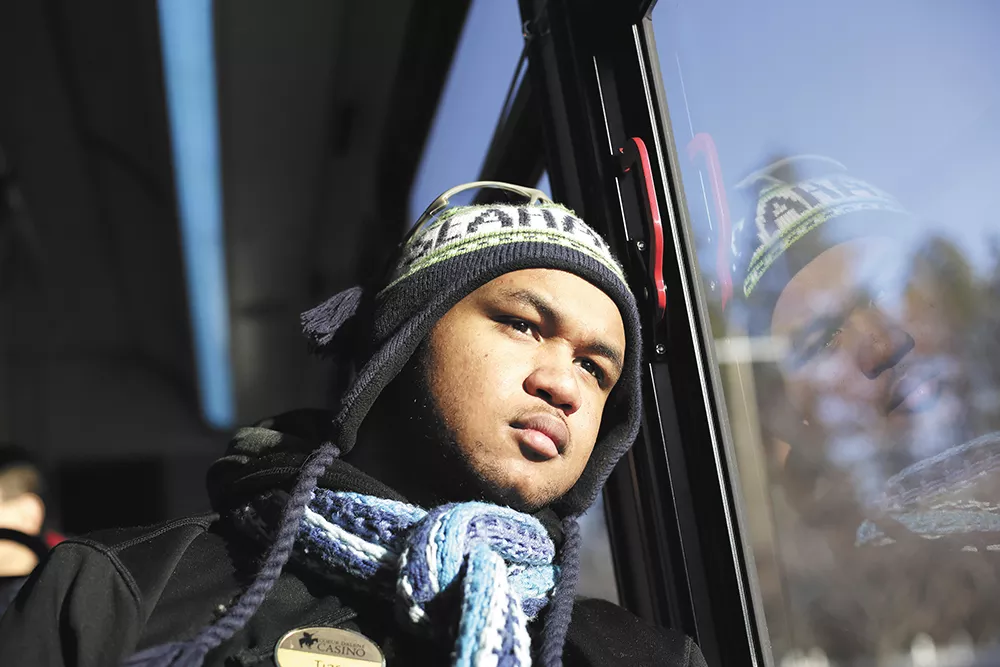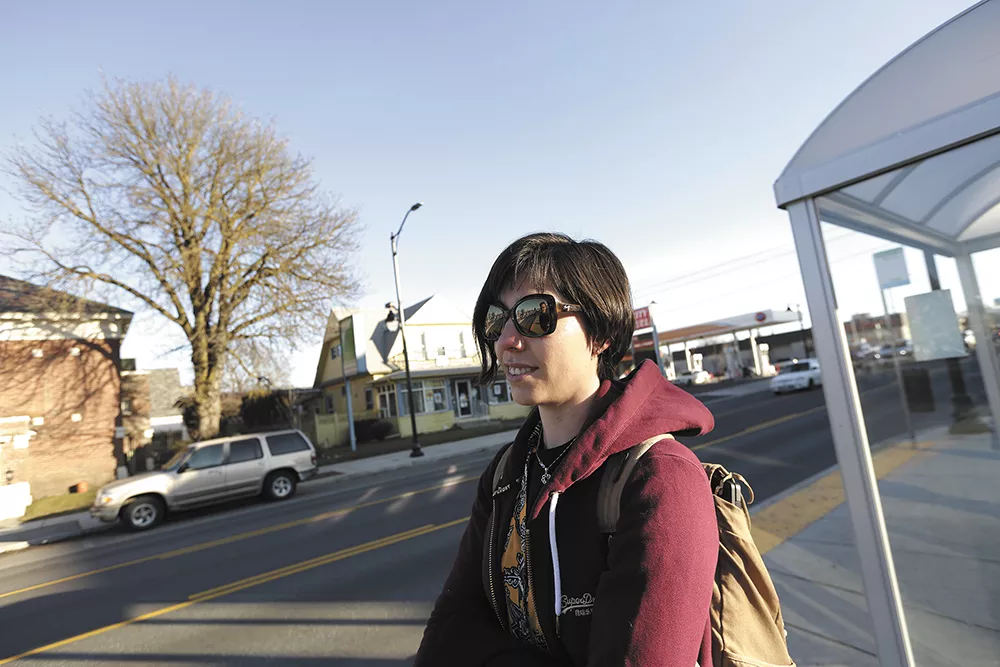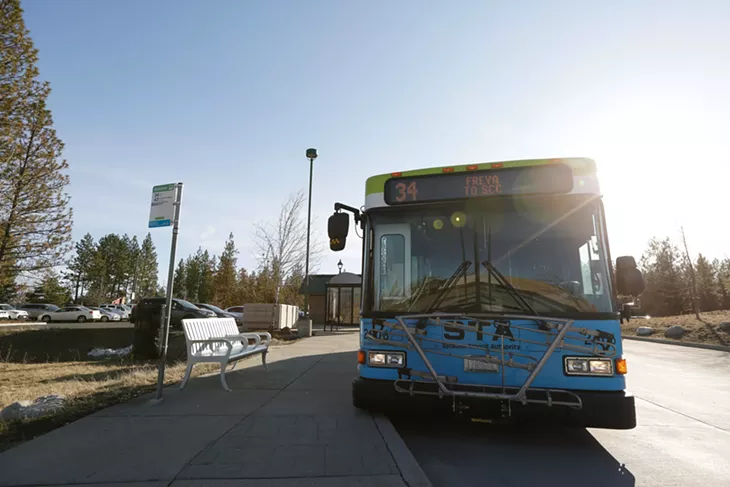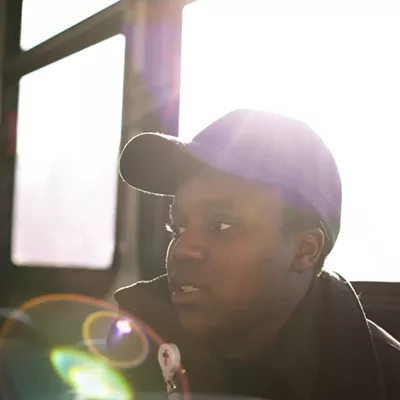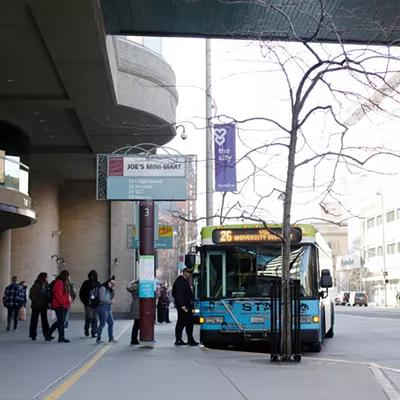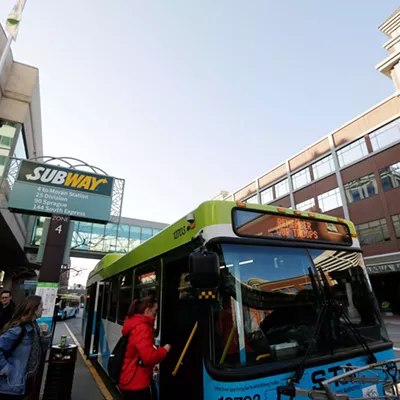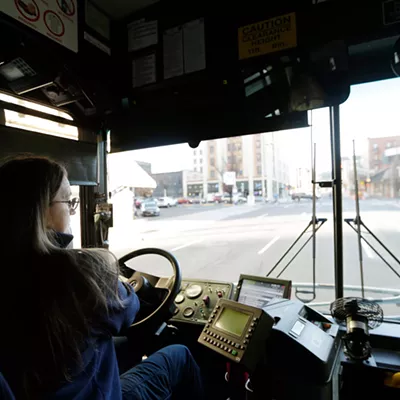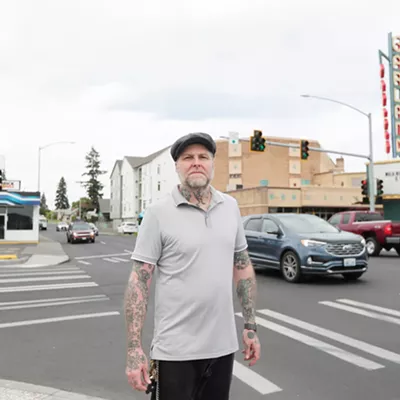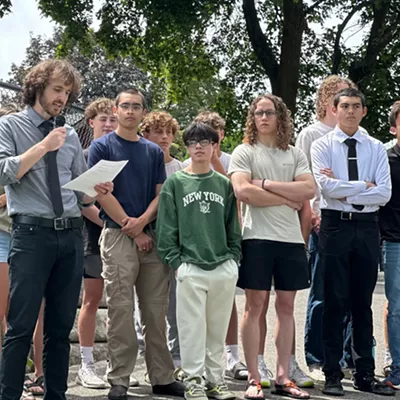Before my car broke down, I didn't ride the bus. Not that I have anything against public transit, but I didn't really have a practical reason to use it: Traffic in Spokane isn't awful, I can afford car-related expenses, and parking is easy enough to find. But with my dated Subaru crippled on the other side of the state, I had no other option. I rode the Greyhound back into town and was involuntarily wedded to Spokane's buses from that point on. The horror! The horror!
But so far, I've been generally impressed with Spokane's public transit. The buses are on time, clean, and get me to dentist appointments and the local Goodwill. But I also end up wasting a lot of time waiting for infrequent buses on some routes. And there are other ways that the system is lacking: It's tricky to go anywhere in the city without getting routed through downtown, there's limited fare options for low-income riders, and ridership has been dropping over the last few years.
At the same time, the network has a lot going for it. As a result of a 10-year funding plan that voters approved in 2016, Spokane Transit Authority (STA) has been rolling out a slew of heavyweight projects. High-frequency, 15-minute bus service now runs the length of North Monroe Street while construction on the long-awaited and high-profile City Line project is expected to begin this spring.
With both its successes and shortcomings in mind, we put Spokane's bus system to the test to see what's working, what isn't, and where it's going.
WHO RIDES THE BUS?
In Spokane, like most American cities, the automobile reigns supreme. Some of the city's old streetcar lines were literally paved over in the 1930s as people pivoted to cars for transportation. Now, an estimated 68 percent of people traveling to downtown Spokane get there by driving alone, according to a 2019 consultant study. In comparison, a meager 4 percent of people took transit to get downtown. In fact, ridership on Spokane's buses has been slowly dropping since it peaked in 2014 — a decline that matches a nationwide trend in transit that experts attribute to numerous factors, like low gas prices, a good economy and rideshare services like Uber and Lyft.
But those stats obscure the over 10 million rides taken annually on STA's buses. They're students, families, seniors, blue- and white-collar workers doing daily commutes, and people going out on the town to events like Hoopfest and Bloomsday. The reasons why they take mass transit are varied, ranging from convenience and cost to, as riders told us, the pure enjoyment of the bus.
Take Bethany Medina, 35, who commutes on a daily basis from her home on the South Hill to downtown to her job at Washington Trust Bank. She could drive, but she says it's "way less expensive" to take the bus given the price of parking.
Bus riders aren't just jumping between destinations in the heart of Spokane. Some of the most popular routes in 2018 were the high-frequency No. 25 route running along North Division (clocking in with 931,056 boardings), the 66 that zips between Spokane and Eastern Washington University in Cheney (494,466 boardings), and the high-frequency 90, which takes a beeline down East Sprague to Spokane Valley (logging a whopping 925,798 boardings). People are using the system and covering some serious ground while they're at it.
Like Sharon Belton, 47, who rides the bus on a daily basis during her commute from central Spokane out to Spokane Valley to do home health care work. She relies exclusively on her bike and the bus to get around.
"It's pretty efficient," Belton says. "It's more relaxing than having to actually be the driver and deal with all the chaos."
Tiar Atoigue, a 23-year-old bus rider, has a monster of a daily commute: He lives near the NorthTown Mall and works at the Coeur d'Alene Casino doing housekeeping and uses a combination of local buses and a shuttle that the casino runs to and from Spokane to get to his job. Atoigue says that while a car might be more convenient, he's not "financially ready" for one.
Besides, he also just likes riding the bus.
"I like riding them just for fun. Riding the bus helps my depression," Atoigue says. "I have a hard time just being stuck at home."
Bus riders are also more diverse than the general population: While they're still overwhelmingly white, they're disproportionately black, Latino and Native American in comparison to the county's overall demographics, according to a 2018 rider survey commissioned by the STA. Class-wise, it skews towards people making low incomes. While the survey found that the average annual income of riders is $22,400 — over one-quarter reported making less than $12,140 annually — an estimated 16 percent earn more than $38,059 every year.
But the notion that riding Spokane's buses is a second-tier mode of transportation or strictly a measure of last resort for those who can't afford a car is inaccurate, transit proponents say.
Jack-Daniyel Strong, president of Strong Solutions (an Apple IT consulting business) and the former president of the East Spokane Business Association, regularly rides the bus to get to work, taking the 4 or 124 routes to get downtown and then the 90 to get out to his office on East Sprague Avenue.
"Spokane has had a long-time attitude that mass transit is for poor people. I don't consider myself a poor person, I ride the bus all the time," he says.
WHAT'S MISSING
There's a lot to like about Spokane's bus system. But there are still issues, including the lack of a dedicated bus route to Coeur d'Alene and insufficient east-west routes within Spokane.
But one of the biggest criticisms is about the frequency of Spokane's buses, or general lack thereof.
While the STA has rolled out several high-frequency routes that run on 15-minute intervals during the daytime hours, many buses show up at stops every 30 minutes. In the evenings and on the weekends, those intervals drop considerably to 60 minutes or simply don't run at all. Currently, STA only runs six 15-minute interval high-frequency routes.
For transit experts, frequency — typically defined as 15 minutes or less — is one of the major factors in boosting ridership. Intuitively, it makes sense: People hate waiting for the bus.
"Frequency has been shown to be one of the strongest pushes for increasing ridership and reliability and rider satisfaction and also making it a service that is used by people who have other choices," says Jessica Engelman, founder of SpokAT (derived from Spokane Active Transportation), an alternative transportation advocacy group. "If you don't own a car and walking or biking to a destination isn't an option, you'll take a bus if it comes every half-hour or hour. You're a captured audience. But if you have the option of driving, why would you take the bus?"
In Richmond, Virginia, for example, the combination of a new bus-rapid-transit line that opened in summer 2018, in addition to a redesign of the bus network that included increased frequency, boosted ridership by 17 percent in just one year.
The new high-frequency Monroe-Regal line introduced last fall, which runs every 15 minutes on weekdays, is a local case study in the popularity of frequent transit.
"It's now the busiest route in our system," says Karl Otterstrom, STA's director of planning and development. "Certainly, there is growth in ridership no matter where it is based on increasing frequency."
Still, anecdotes about waiting arduously long for Spokane's buses are abundant.
"I had a meeting in the Hillyard area and I ended up walking 3 miles home because I missed the bus and the next one wasn't coming for an hour," Strong says. "I could walk it in 45 minutes. Was it convenient? No, it was snowy and icy out. But this is what pedestrians are left with."
"I wish they would extend them more on the weekends," Belton says, recalling a time that she had to spend a night at a friend's house in Spokane Valley because she missed her bus. "It's so easy to get stuck."
Both STA officials and members of its governing board are well aware of the concern. For them, it's a cost-benefit analysis: How to maximize ridership and the coverage area most effectively with limited financial resources. (Roughly three-quarters of STA's funding comes from voter-approved sales taxes, while the rest comes from passenger fares and various government grants.) Factors like commercial and residential density and community feedback come into play as well.
"If cost wasn't a factor, you'd provide transit everywhere. But cost is a factor and taxpayers who pay for the service expect accountability," says Spokane County Commissioner Al French, who chairs the STA Board of Directors. "If the most I can afford to spend on a route is 30-minute frequencies, but I can deliver service to an area that might otherwise not be served, am I better to do the 30 minutes or not do the service at all?"
Jarrett Walker, a Portland-based public transit consultant and author of Human Transit: How Clearer Thinking About Public Transit Can Enrich Our Communities and Our Lives, says that issues with Spokane's bus frequency are reflective of the political balancing act that transit agencies across the nation face.
"No transit agency that I know [of] has been directed by its board to design a network for maximum ridership," he says. "A network for maximum ridership would not go to many places. It would only go to places for clear high-ridership potential as dictated by the land use and development. No one finds that politically acceptable so transit agencies are required to run a certain amount of low-ridership fixed-route services."
Some stakeholders also criticize the radial nature of the bus network: Most routes circle back to the STA Plaza in downtown Spokane, meaning that riders trying to head east or west often have to transfer downtown before getting to their destination. In North Spokane, for instance, the only elongated east-west routes are the 33 (a high-frequency route), which spans Wellesley Avenue, and the 22 and the 27, which together cover Francis Avenue.
"I live in northeast Spokane. If I want to get to northwest Spokane, I have to take a bus downtown, transfer and then get back out," says Kate Burke, a Spokane city councilwoman representing northeast Spokane and an STA board member. "It works well if you're just trying to go downtown, but if you're trying to go to another area of town, that's really difficult."
Otterstrom says that the concentration of jobs, events and various attractions in downtown Spokane, coupled with demand for high-frequency bus service, lead to a network that's skewed towards routing routes through downtown: "There are trade-offs with people making connections via transfers," he says.
Another major hole in the regional system is the lack of a dedicated public transit route to Coeur d'Alene. An estimated 4,128 Spokane County residents work in Kootenai County and 9,322 Kootenai County residents work in Spokane County, according to Sam Wolkenhauer, a regional labor economist at the Idaho Department of Labor. Those figures are decent indicators of cross-border commuting.
Currently, STA has set a loose goal of adding bus service to Coeur d'Alene by 2025. Brandon Rapez-Betty, a spokesman for STA, says that the idea is to have a "fixed-route commuter-focused bus service." However, the project is still pretty theoretical.
Commissioner French says that he's brought the idea up with Kootenai County officials in the past, but that it always stalled out due to a lack of funding on the Idaho side.
"I think it's worth pursuing in the near future," he says. "The challenge is how do we fund it."
THE VISION
In 2016, voters approved a 10-year STA project plan dubbed "Moving Forward" — greenlighting a bump in local sales taxes to fund it. The ballot measure covered everything from extending night service on Saturdays, constructing park-and-rides, establishing more high-frequency bus service (such as the now popular Monroe-Regal No. 4 route) and the high-profile City Line project.
As STA officials see it, the vision is to have regional "corridors" that offer high-frequency service with connecting routes branching off of them.
"The biggest part of the vision is the high-performance transit network, which is corridors around the region that have all-day two-way frequent service," Otterstrom says. "The City Line is the key centerpiece of the 10-year plan right now for implementing that bigger long-term vision."
The City Line, previously called the Central City Line, will run 6 miles from Browne's Addition to Spokane Community College through downtown at intervals of around seven minutes. It'll be Spokane's first "bus rapid transit" project, a term that describes high-capacity, fast, and frequent service along a specific corridor. The buses will be all electric and will feature pre-board ticketing, meaning passengers can enter from all doors of the bus. Transit officials predict that the service will garner an estimated 1 million rides annually.
There are purported economic benefits as well: A 2014 study estimated that the project would increase land values along the route by $45 million and generate $175 million in land improvements over several decades.
"The benefit for having public transportation is not only providing access for work and school and medical, but also it reduces the total number of vehicles on the road that we have to share lane miles with," French says. "So there's benefits for those who are users, there's benefit for those who are not users but will benefit because there is less congestion on the roads."
French is a big believer in the economic stimulus impacts of public transit.
"Without transit, a lot of folks would not be able to access retail opportunities, whether it's NorthTown [Mall] or downtown or the local grocery store," he says. "It's a critical element for being able to bring customers to your front door."
The city of Spokane still has to do work to adjust zoning along the City Line route to allow the density — and potential ridership — that planners envision along the route, French says.
"That's something the city has still got to wrestle with," he says.
With sufficient funding lined up for the City Line — over $53 million in federal grant funding was recently acquired — construction on the project is scheduled to begin in May, with an estimated completion date of 2022. And there's more to come in the next few years: Transit officials want to add high-frequency double-decker buses to Cheney, as well as reconfigure routes in northeast Spokane to boost frequency and add more east-west routes.
"If you think about what transit [agencies] around the country are successful in doing, it's frequent transit that's reliable and cost-effective. It serves places that are dense, sort of places that are walkable," Otterstrom adds. "I think that's the best way to describe it because that's really what we're investing in."
The 10-year plan isn't the end of the road, however. The region's population is expected to grow 21 percent by 2040, according to estimates from the Spokane Regional Transportation Council. Jason Lien, a principal transportation planner with the council, says that while the share of people taking public transit isn't expected to change dramatically, mass transit service will have to be increased to meet future demand — especially among a growing senior population who are projected to live far from current transit routes.
To truly build out the system, transit officials envision more projects, such as potentially constructing another bus-rapid-transit project along North Division Street. And more money from the voters would likely be needed to realize those ambitions.
"We didn't expect [the 10-year plan] to be the end-all," Otterstrom says. "I would expect a time when our board wants to bring forward to the public a new strategic plan for action or additional services, different investment in infrastructure."
"I don't think it's out of the question," he adds, referring to future ballot measures. "We're in a growing place and transit is here to grow along with the region."
QUESTIONING FARES
Across the nation, numerous cities and transit agencies are experimenting with (or have long operated) fareless transit, where people don't have to pay anything to ride the bus. Olympia's bus network, Intercity Transit, went fareless earlier this year, while Kansas City, Missouri, is implementing a similar program. And just last week, officials in King County approved providing free yearlong bus passes to low-income riders.
"It's definitely gaining more attention now," says Ben Fried, a spokesman for TransitCenter, a pro-mass transit think tank in New York City. "Kansas City was a pretty high-profile example of a larger urban place deciding to go fareless."
Locally, some stakeholders have been calling for more affordable (or free) bus pass options for low-income riders. While the STA has deals with local colleges and the Kendall Yards Business District Association to provide free bus passes to their respective clientele, there is no dedicated bus pass for low-income riders, aside from passes that nonprofit service providers buy from the transit agency and discounted monthly passes for seniors, disabled riders or Medicare recipients. And regular payment options aren't exactly inexpensive: Aside from paying the $2 cash fare, riders can buy $4 day passes, monthly $60 passes, seven-day passes for $17, or put money on bus cards at the STA Plaza.
"We have many individuals who are living on less than $700, $800 dollars a month," says Cameryn Flynn, transportation coordinator at Spokane Neighborhood Action Partnership, a human services provider. "Transportation is a huge barrier to get people to and from services, to resources like food."
Councilwoman Burke has long advocated for a low-income bus pass. She's also open to exploring a fareless system.
"Let's not even talk about people experiencing homelessness or people who don't have jobs, but just people in my district who have four people in their family and don't have a car, it's nearly impossible for them to ride the bus," she says. "The core of the problem is people are having a problem purchasing $60-a-month passes."
"I would love to see a fare-free system," Burke adds. "I would like to see us do some sort of pilot to see how that would play out in our community."
Currently, the STA is exploring ways to provide free passes to low-income riders, at the direction of its governing board. At a Feb. 20 board meeting, Steve Blaska, STA's interim chief operations officer, recommended pursuing a program where nonprofits can buy hourly and daily passes at a 50 percent discount.
But the notion of abolishing fares is largely out of the question, local officials say. For one, STA policy (as approved by the governing board) mandates that fares compose a target goal of 20 percent of operating costs. In 2018, for instance, fares covered 17 percent of operating expenses. And fares strictly finance operating costs — buses on the street, in other words.
"One of the most important things we've heard from customers is that they want more and better transit service," says STA spokesman Rapez-Betty. "That's kind of at odds with cutting revenue by reducing fares."
French is a staunch defender of the current fare system. He views collecting fares as fulfilling a promise to voters who approved the 10-year plan transit funding measure in 2016 that riders will also contribute to the cost of transit.
"When you have riders who aren't sharing that cost, I worry that we are violating that trust of the voters who approved to fund the agency," he says. "We, in our last funding package, committed to a variety of improvements and expansion of the service — none of which was free bus passes."
"We're talking about changing people's lives in measurable ways and immeasurable ways."
In Olympia, transit officials report significant boosts in ridership after their system went fareless: In the first month, ridership increased almost 20 percent.
"The feedback that we're getting from the community is: 'It's really helping out with my budget, I'm able to get to school, I'm taking a new job,'" says Intercity Transit General Manager Ann Freeman-Manzanares. "We're talking about changing people's lives in measurable ways and immeasurable ways."
The shift to a fareless system came after voters approved a sales tax increase last fall for other route services. Previously, fares accounted for roughly 8-10 percent of the transit agency's budget. However, it also cost an estimated $500,000 annually to collect fares, according to Freeman-Manzanares.
In Corvallis, Oregon, a college town of about 58,000 people, the local transit agency went fareless back in 2011. According to Tim Bates, the city's transit coordinator, they witnessed substantial ridership gains. In the first year, he says, ridership went up by 39 percent.
"I can't imagine ever going back," Bates says. "We're still way above anything we came close to before we became fareless."
On the question of going entirely fareless, French says: "If something is free, yes, it is going to be used more, but who pays the bill for that? The taxpayers."
The evidence is mixed on whether changes in fares alone can boost ridership rates. While numerous studies show that fare increases are associated with suppressed ridership, investment in the quality of transit services is also an important factor in increasing use.
"In our surveys of transit riders is that, yes, the price of the fare [matters to] riders but the quality of the service matters more," says Fried of the TransitCenter. For him, going fareless can undermine funding for high-frequency transit that otherwise would boost ridership on its own. "There's a tension between going fareless on one hand and providing a good service that lets people shed the costs of car ownership."
TESTING THE SYSTEM
We wanted to put our local bus system to the test, so I ventured out to the Spokane Valley Mall on a weekend, when bus frequencies drop significantly and some riders reported feeling stranded. Could the bus efficiently get me to and from a major shopping center far away from the urban core of Spokane?
Here's how the experiment played out: On a recent brisk and overcast Saturday afternoon, I start at the STA Plaza. Google Maps tells me that at 1:35 pm, Route 29 to Spokane Community College will get me to the mall in roughly an hour.
When the 29 arrives (and it's on time), the bus fills up. I ask the bus driver if the bus does indeed go to the mall. She answers: "eventually." Onboard is a mix of youth, adult professionals and older, disheveled men who appear to be going through some hard times.
After a brief stop at the transit center at Spokane Community College where the bus turns into another route — there's a brief moment of comedic suspense where some riders joke that the bus has broken down — we take off down East Trent Avenue. It's a largely industrial stretch of road, but we're still routinely picking people up and dropping them off along the way; the bus stays pretty full and we're moving along the route at a good clip. Cars generally don't seem to be passing us, except for when we stop.
After about an hour, we arrive at the mall, where I hop off. I pop my head in the mall briefly before realizing that the next bus isn't for another 50 minutes. So I end up inhaling a teriyaki chicken rice bowl before planting myself at the bus stop to wait. If I were spending 45 or 90 minutes shopping, the intervals would be convenient. But if you wanted to run in and out of the mall quickly, you might end up waiting over 45 minutes for the next bus.
To return, the next bus heading west is late, but only by a few minutes. Again, it's surprisingly full, and we roll back into Spokane with a posse. The trip takes almost exactly an hour, as predicted. Talk about on-time performance!
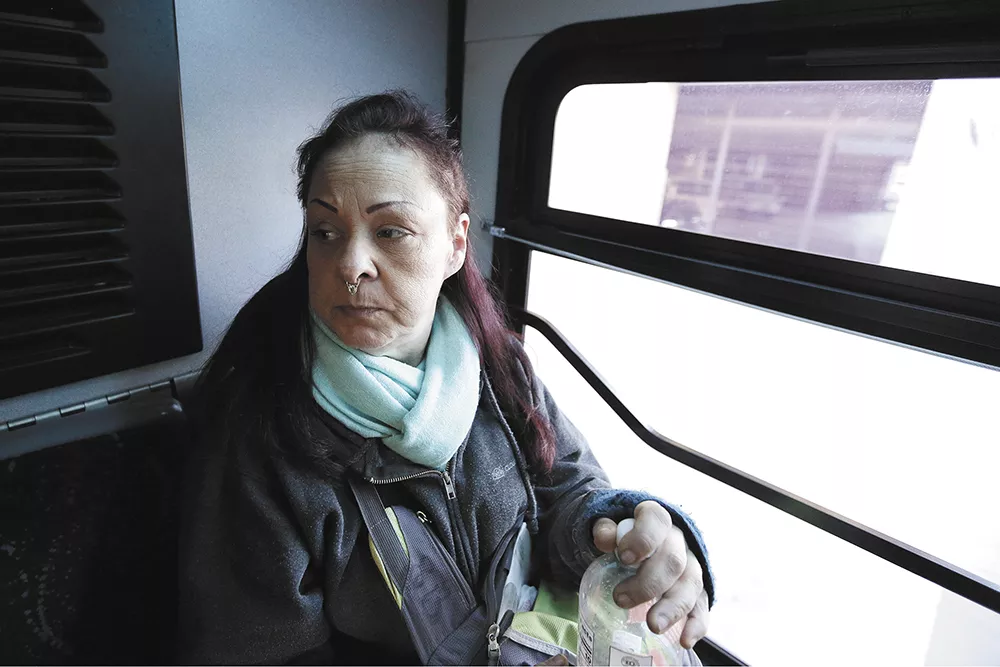
Afterward, I compare STA's performance against other modes of transport. A bike ride (mostly along the Centennial Trail) would have matched the bus, taking me about an hour in each direction, Google Maps tells me. Walking would be a slog of almost four hours. As for a car, it would be a roughly 20-minute ride. But as I mentioned above, my car died, and I have places to go. ♦
BY THE NUMBERS
- A standard two-hour pass: $2
- Number of rides in 2018: 10,069,599
- Total STA revenue in 2018: $104.7 million, composed of bus fare, sales taxes and other government funding
- Percent of revenue from passenger fares in 2018: 11 percent
- Percent of revenue from local sales taxes in 2018: 70 percent
FEEDBACK
The STA is currently seeking feedback on its proposed changes to bus service from downtown Spokane to the West Plains and Cheney. They want to turn it into a major transit corridor by boosting bus frequency, hours of service, and add double-decker buses to move riders. The proposed changes would fold the existing No. 64 route into a new line, the 6, while maintaining the 66 to help support the new route during peak periods. The agency is taking feedback through an online survey through March 13. Here's a link: surveymonkey.com/r/cheneyline.
BUS RIDER TOOLKIT
For smartphone users, there are plenty of apps that can help you navigate the local bus system on a daily basis. For one, Google Maps uses real-time data from Spokane Transit Authority and is fairly reliable. Otherwise, bus riders can use apps that rely on transit agency data, like OneBusAway and Moovit. Then there's Transit, an all-encompassing app that not only includes bus data but also lets you check local bike-sharing locations and Uber or Lyft availability and pricing. As far as bus fare, one can pay cash for a two-hour pass or a day pass on the bus, or buy monthly or weekly passes three different ways: online, at local retail stores or at the STA Plaza. "Smart Cards" are also available at the STA Plaza to add money or passes to as you see fit. Smart Cards, however, can only be reloaded at the Plaza. (JK)
LIGHT RAIL DREAMS
Years ago, near the turn of the century, regional officials were toying with the idea of building a regional light rail system. But voters weren't of the same mind. In 2006, two advisory votes on a proposal to construct a light rail line between the airport and Liberty Lake were rejected at the ballot. The STA board subsequently (and unanimously) disbanded the steering committee overseeing the light rail initiative. But that wasn't the end of officials' transit ambitions. Officials looked into deploying a much smaller streetcar system or a series of electric buses. Eventually, they landed on "bus rapid transit" and worked to get various funding sources together — including getting voters to approve a tax increase for mass transit in 2016 — to finance what is now called the City Line project. (JK)
ABOUT THE AUTHOR
Josh Kelety is a staff writer primarily covering Spokane County government and criminal justice issues. He's written about police misconduct, how jails are dealing with the opioid crisis, a local addiction counselor who led a double life as a drug dealer, and the ways that telecom corporations profit off of prison inmates. He can be reached at joshk@inlander.com or at 325-0634 ext. 237.


